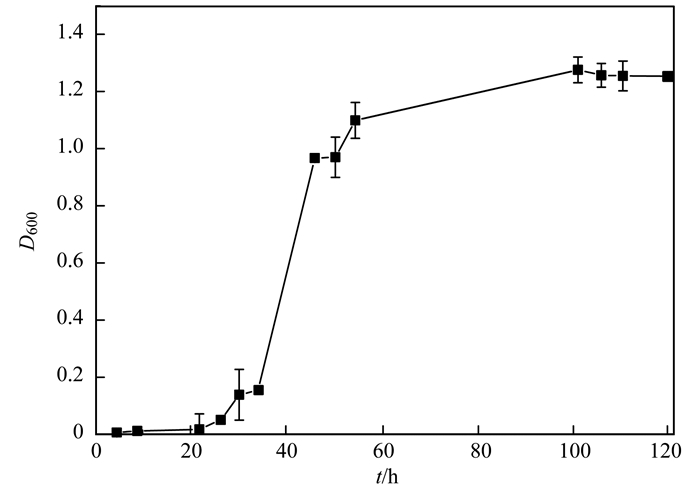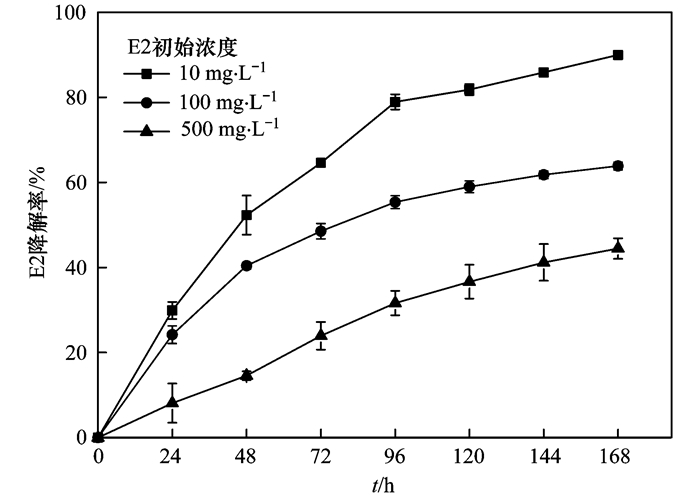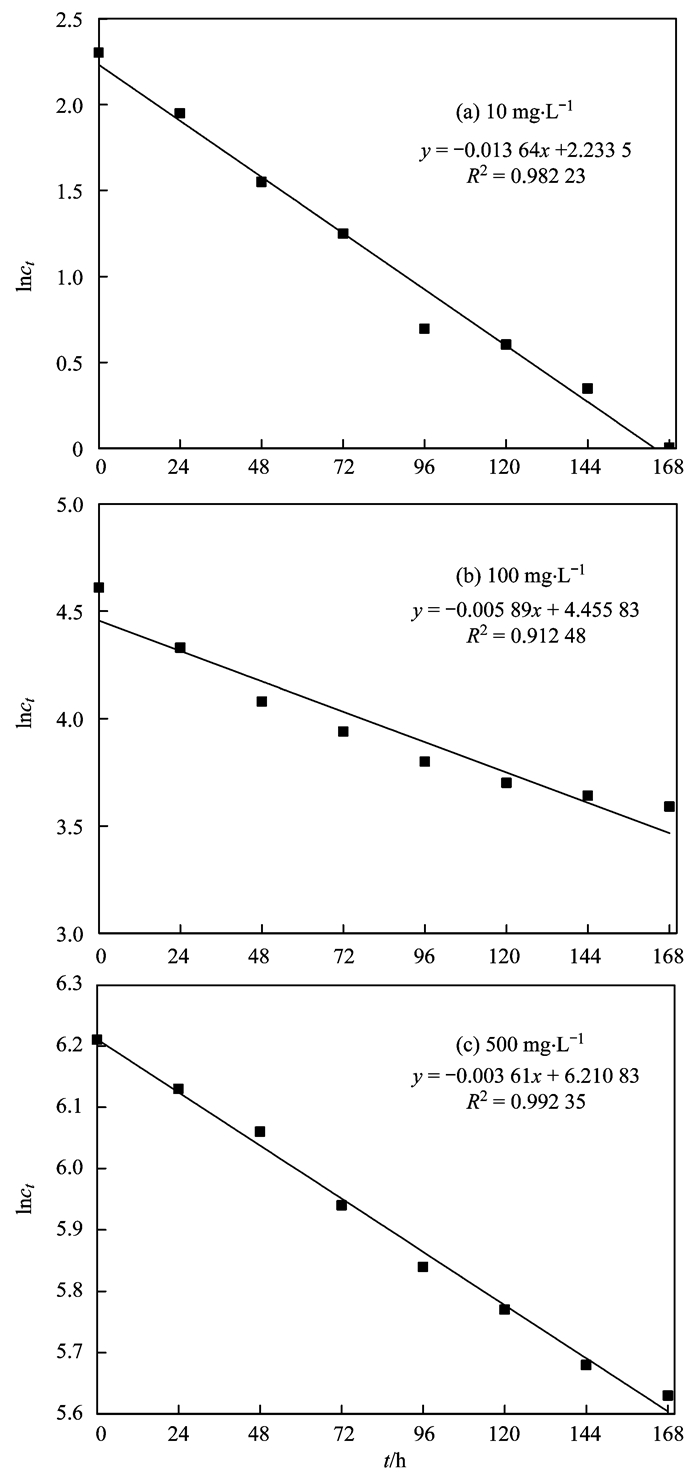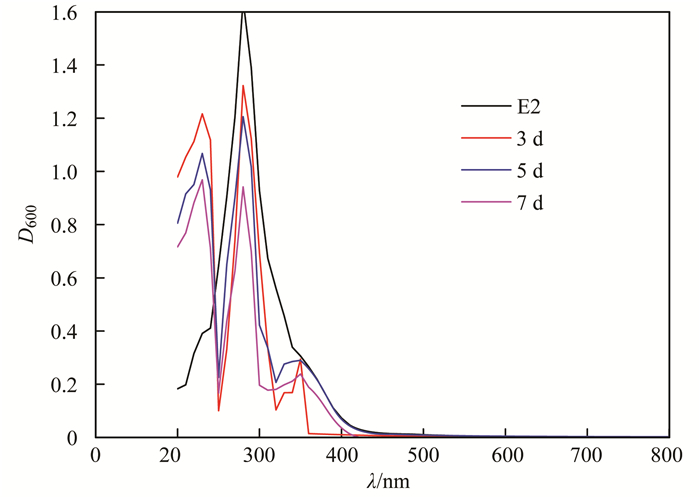环境内分泌干扰物(endocrine disrupting compounds, EDCs)是对人体或动物体的生殖、神经、免疫系统产生影响并具有致癌作用的一类外源性化学物质.近年来, 由于雌激素类药物在日常生活和养殖业中的大量使用, 使得排放到环境中的内分泌干扰物日益增多.目前, 在许多水域及污水处理厂均已发现环境内分泌干扰物质的存在, 这些内分泌干扰物质对水域周围食物链系统内的动物产生不同程度的影响[1, 2].
17β-雌二醇(17β-Estradiol, E2)是一种典型的类固醇类内分泌干扰物.在ng·L-1浓度水平下即可对水生生物的内分泌系统造成干扰[3].污水处理厂进、出水中常含有该类物质[4~7].利用普通的水处理技术很难将水体中的雌激素彻底去除[8~10].
微生物降解被认为是去除环境中类固醇激素的主要途径.目前文献报道的可降解类固醇激素的降解菌属主要包括红球菌(Rhodococcus sp.)、枯草芽孢杆菌(Bacillus subtilis)、香茅醇假单胞菌(Pseudomonas citronellolis)、鞘氨醇杆菌(Sphingobacterium sp.)、欧洲亚硝化单胞菌(Nitrosomonas europaea)、黄杆菌(Flavobacterium sp.)、诺卡氏菌(Nocardia sp.)、铜绿假单胞菌(Pseudomonas aeruginosa)等细菌[11~21].
与细菌相比, 真菌具有较强的环境适应能力和抗毒性, 对于降解存在于环境中的雌激素具有一定的优势[22]. Křesinová等[23]对1株可降解雌二醇的糙皮侧耳菌(Pleurotus ostreatus)进行了详细报道, Eibes等[24]报道了1株木质素烟管菌(Bjerkandera adusta)对包括雌二醇等雌激素在内的多种药物的氧化降解情况. Wang等[25]对白腐真菌(White-rot fungus)降解5种典型雌激素的情况进行了详细研究.但总体而言, 目前有关真菌降解雌二醇的研究工作文献报道相对较少.
本研究以某污水处理厂A2/O工艺的好氧池活性污泥作为雌二醇降解菌的优良菌源, 以MYE培养基作为真菌筛选培养基, 利用平板划线分离法获得1株可降解雌二醇的镰刀菌属.利用高效液相色谱分析和紫外光谱法对菌株降解雌二醇的降解特性进行了研究, 结果对于水环境中内分泌干扰物的有效去除和彻底净化具有重要的理论和现实意义.
1 材料与方法 1.1 实验材料17β-雌二醇(E2, 纯度99.8%), 购自Sigma-Aldrich公司; 乙酸乙酯(纯度99.9%), 购自德国Merck公司; 实验中所用甲醇和乙腈均为色谱级别; 超纯水, Pure-Lab Option R7+Ultra Genetic(英国ELGA公司).
活性污泥:取自西安市某污水处理厂A2/O工艺的好氧池, 样品取回后置于4℃冰箱中保存, 尽快进行后续操作.
MYE筛选培养基:麦芽浸粉20 g·L-1, 酵母膏2.0 g·L-1, 氯霉素0.1 g·L-1, 超纯水配制. 120℃高压灭菌30 min.
MYEA固体培养基:麦芽浸粉20 g·L-1, 酵母膏2.0 g·L-1, 氯霉素0.1 g·L-1, 琼脂20 g·L-1, 超纯水配制. 120℃高压灭菌30 min.
1.2 实验方法 1.2.1 降解菌的富集、筛选与鉴定移取5.0 mL浓度为100 mg·L-1的E2甲醇溶液, 加入到100 mL灭菌的MYE筛选培养基中, 振荡30 min使甲醇挥发, 在无菌操作台上加入10 mL活性污泥进行接种, 于150 r·min-1、30℃条件下恒温水浴振荡培养3 d, 吸取2 mL培养液转接到含5 mg·L-1 E2的50 mL MYE培养基中, 相同条件下继续振荡培养3 d, 如此重复转接6次.驯化结束后, 在MYEA平板上进行多次划线分离, 获得1株可以利用E2为单一碳源进行生长的单菌落, 命名为Wu-SP1.将获得的菌落接种于MYEA培养基斜面上, 置于4℃冰箱保存.
提取并纯化降解菌Wu-SP1的DNA, 利用真菌通用引物NS1(GTAGTCATATGCTTGTCTC)和FUNG(ATTCCCCGTTACCCGTTG)[26]对真菌基因组DNA进行全序列PCR扩增.将扩增产物送生工生物工程股份有限公司(Sangon Biotech, 上海)进行基因测序, 序列信息输入NCBI(National Center for Biotechnology Information, http://blast.ncbi.nlm.nih.gov/Blast.cgi)数据库进行BLAST比对.利用MEGA5软件采用邻接法(Neighbour Joining, NJ)构建系统发育树.
1.2.2 菌株的生长曲线向100 mL灭菌的MYE培养基中接种保存的菌株Wu-SP1, 在30℃、150 r·min-1条件下振荡培养5 d, 每隔一定时间, 以MYE空白为参比, 在600 nm波长下测定体系的光密度值.
1.2.3 菌悬液的制备在无菌操作台上用接种环挑取斜面上保存的E2降解菌Wu-SP1, 接种在100 mL MYE培养基中, 于150 r·min-1、30℃的条件下振荡培养48 h.将培养好的菌液用8层纱布(使用前灭菌)过滤, 弃去滤液, 用少量无菌水洗涤截留在纱布上的菌体, 并收集在小烧杯中, 用PBS缓冲液进行稀释, 调节菌悬液的光密度值为1.0(波长600 nm处进行测定, 相当于2.4×107CFU·mL-1菌落数).
1.2.4 17β-雌二醇(E2)的测定利用LC-2000型高效液相色谱仪(JASCO公司)对17β-雌二醇进行测定.检测器: MD-2010型二极管紫外阵列检测器(PDA); 色谱柱: Agilent 5 TC-C18(250 mm×4.6 mm, 5 μm); 流动相:乙腈/水=60/40, 流速: 1 mL·min-1; 进样体积: 100 μL; 柱温:室温; 测定波长: 282 nm.
1.2.5 温度、pH值对菌株降解E2的影响温度的影响:取系列锥形瓶, 分别加入50.0 mL PBS缓冲溶液、100 mg·L-1的E2甲醇标准溶液1.0 mL, 振荡30 min使甲醇挥发(此时体系中E2浓度为2 mg·L-1), 加入D600=1.0的Wu-SP1菌悬液1mL, 分别在4、25、30、40、50℃的条件下进行24 h的降解实验, 利用甲醇作为萃取剂进行萃取, 利用高效液相色谱法测定体系中的E2浓度.
pH值对降解效果的影响:取系列锥形瓶, 分别加入50.0 mL PBS缓冲溶液, 1.0 mL浓度为100 mg·L-1的E2标准溶液液、1mL菌悬液(D600=1.0), 调节锥形瓶中各体系的pH值分别为4、5、6、7、8、9、11, 在30℃条件下进行48 h降解实验, 提取并测定体系中的E2浓度.
1.2.6 菌株对E2的降解动力学准备系列锥形瓶, 分成3组, 每组中E2浓度分别为10、100、500 mg·L-1.每瓶中分别加入E2降解菌4.8×106 CFU·mL-1(加入0.2 mL D600=1.0的菌悬液).在最适pH值和温度条件下进行连续7 d的降解实验, 每天取各组中的一瓶测定E2的浓度, 以不加菌的体系作为空白对照, 每个实验3个平行.
采用一级反应动力学公式[式(1)]对测定结果进行拟合.

|
(1) |
式中, c0:体系中E2的初始溶液, mg·L-1; ct: t时刻体系中E2的浓度, mg·L-1; k: E2降解速率常数, h-1; t:降解时间, h.
1.2.7 雌二醇降解产物的紫外光谱分析向锥形瓶中加入50 mL PBS, 加入E2使其在体系中的浓度为50.0 mg·L-1, 加入4.8×106CFU·mL-1降解菌, 在最佳温度和pH条件下进行降解, 以不加降解菌的体系作为对照.分别在降解3、5、7 d时取样, 用5 mL乙酸乙酯进行萃取, 以乙酸乙酯为参比溶液, 利用紫外光谱仪(UV-3100PC)在200~800 nm范围内对萃取液进行扫描得到降解体系的紫外光谱图.
2 结果与讨论 2.1 降解菌Wu-SP1的生长特性及鉴定结果以污水处理厂好氧池活性污泥为菌源, 以MYE为分离筛选培养基, 经过多次富集培养和平板划线分离, 获得了1株能以E2为唯一碳源生长的真菌.该菌落在固体平板培养基上呈圆形, 表面低凸, 边缘完整, 湿润, 有光泽, 呈橙色并带有白色菌丝(图 1).

|
图 1 E2降解菌Wu-SP1的培养特征 Fig. 1 Culture characteristics of E2 degrading bacteria |
对菌株Wu-SP1申请的序列号为KY123915. Blast结果显示该菌株的18S rDNA基因序列与NCBI数据库中的许多镰刀菌属(Fusarium sp.)基因序列同源性为100%.结合菌株的形态以及构建的系统发育树(图 2), 将菌株Wu-SP1鉴定为镰刀菌属.

|
图 2 E2降解菌Wu-SP1系统发育树的构建 Fig. 2 Phylogenetic tree of E2 degrading bacteria |
镰刀菌属是自然界中广泛存在的一种真菌, 环境适应性强.有研究报道了利用镰刀菌属降解苯酚、三氯苯酚、原油等的相关研究工作[27~31], Shi等[32]对1株可降解雌激素的镰刀菌属进行了详细研究.但总体而言, 利用镰刀菌属降解雌激素的研究工作目前报道相对少.
镰刀菌属Wu-SP1的生长曲线如图 3所示.在120 h内, 菌株在MYE培养基中的生长经历了3个时期:在0~22 h为生长延滞期, 该阶段菌株生长缓慢; 22~60 h为对数生长期, 降解菌在该阶段内迅速生长繁殖; 60~120 h内降解菌的生长处于稳定平衡期, 这一阶段真菌在MYE培养基中繁殖速度减缓, 菌数趋于稳定.

|
图 3 E2降解菌的生长曲线 Fig. 3 Growth curve of E2 degrading bacteria |
温度、pH对菌株降解E2的影响作用如图 4所示.当体系温度为30℃时, 菌株Wu-SP1对雌二醇的降解活性最好, 降解24 h时E2降解率为53%. pH值为6时, Wu-SP1对E2的降解效果最好.降解48 h的E2去除率可达到92.5%.并在弱酸性范围内(pH 4~6), 菌株对E2呈现较好的降解活性.

|
图 4 温度和pH对菌株Wu-SP1降解E2的影响 Fig. 4 Effects of temperature and pH on the degradation of E2 by strain Wu-SP1 |
固定体系中菌量为4.8×106 CFU·mL-1, 对浓度分别为10、100、500 mg·L-1的E2进行连续7 d的降解实验, 结果如图 5所示.当E2初始浓度分别为500、100、10 mg·L-1时, E2的7 d降解率分别为38.5%、59.2%、86.1%.对不同初始浓度E2进行一级动力学模型拟合, 所得的相关系数值(R2)均大于0.9, 说明菌株Wu-SP1对10~500 mg·L-1 E2的降解符合一级动力学反应(图 6).

|
图 5 菌株Wu-SP1对不同浓度E2的降解效果 Fig. 5 Degradation rates of different concentration of E2 by strain Wu-SP1 |

|
图 6 降解菌对不同浓度E2的降解动力学分析 Fig. 6 Degradation kinetics of different concentrations of E2 by strain Wu-SP1 |
表 1为不同浓度E2的降解动力学参数.从中可知, 镰刀菌属Wu-SP1对10、100、500 mg·L-1E2的降解速率常数分别为0.01364、0.00589、0.00361 h-1.在菌量一定时, 雌二醇的降解速率随初始浓度的增大而减小.
|
|
表 1 不同E2浓度的降解动力学参数 Table 1 Degradation rate constants for different concentrations of E2 |
相关研究报道的一些微生物降解雌激素的速率常数如表 2所示.史江红等的系列研究中, 获得的1株层生镰刀菌属(Fusarium proliferatum)[32]对初始浓度为25 mg·L-1的EE2降解速率常数为0.025 h-1; 1株氨氧化细菌(Nitrosomonas europaea)[33]对0.4 mg·L-1 E2降解速率常数为0.0020 h-1; 1株香茅假单胞菌(Pseudomonas citronellolis)[15]对4.0 mg·L-1 E2降解速率常数为0.221 h-1.胡碧波等[34]利用1株包埋硝化菌对水中的17β-雌二醇进行降解研究时发现, 在E2初始浓度为880.0 ng·L-1时, 包埋硝化菌(nitrifying bacteria)投加体积比为5%的条件下, E2的生物降解反应速率常数为0.11 h-1.
本研究中, 分离筛选出的镰刀菌属降解菌Wu-SP1对雌二醇的降解过程符合一级动力学, 与多数已有报道相符,而且对浓度很大的雌二醇(500 mg·L-1)仍然具有较好的降解活性.
|
|
表 2 文献报道的不同菌属对雌激素降解的速率常数及浓度 Table 2 Degradation rate constants of EDCs by different degrading bacteria reported in the literature |
2.4 中间产物的紫外扫描谱图分析
以乙酸乙酯为溶剂, 对降解不同时间的E2中间产物紫外谱图进行扫描, 结果如图 7所示.在278~281 nm处出现的最大吸收峰是由E2单体产生的.随着降解时间的增加, 最大吸收峰强度减弱, 说明E2被逐渐降解.与E2单体的紫外谱图相比, 在降解3、5、7d的中间产物谱图中, 代谢产物在230 nm和350 nm处出现了较大吸收峰.根据文献[17], 不饱和醛酮的K带一般出现在230 nm处.因此, 降解中间产物中可能有醛类物质或酮类物质存在.

|
图 7 不同降解时间内E2降解的中间产物紫外扫描谱图 Fig. 7 Ultraviolet spectra of intermediates at different times |
从西安市某污水处理厂A2/O工艺的好氧池活性污泥中分离筛选出1株可降解雌二醇的镰刀菌属KY123915.该菌株降解雌二醇的最适温度为30℃, 最佳pH值为6, 在此条件下菌株对2 mg·L-1雌二醇的48 h降解率可达92.5%.当菌量为4×106CFU·mL-1时, 对初始浓度为10、100、500 mg·L-1的雌二醇降解7 d时的降解率分别为86.1%、59.2%、38.5%, 降解率随底物浓度的增大而减小, 降解过程符合一级动力学反应.对10 mg·L-1雌二醇的降解速率常数可达0.01364 h-1, 并对高浓度雌二醇(500 mg·L-1)仍具有较好的降解活性.
| [1] | McCarty P L, Reinhard M, Rittmann B E. Trace organics in groundwater[J]. Environmental Science & Technology, 1981, 15(1): 40-51. |
| [2] | Chang H S, Choo K H, Lee B, et al. The methods of identification, analysis, and removal of endocrine disrupting compounds (EDCs) in water[J]. Journal of Hazardous Materials, 2009, 172(1): 1-12. DOI:10.1016/j.jhazmat.2009.06.135 |
| [3] | Ternes T A, Stumpf M, Mueller J, et al. Behavior and occurrence of estrogens in municipal sewage treatment plants-Ⅰ. investigations in Germany, Canada and Brazil[J]. Science of the Total Environment, 1999, 225(1-2): 81-90. DOI:10.1016/S0048-9697(98)00334-9 |
| [4] |
吴蔓莉, 时艺馨, 李炜, 等. 高效液相色谱-二极管紫外阵列/荧光串联测定雌激素的方法及污水处理厂对雌激素的去除特性[J]. 环境工程学报, 2017, 11(4): 2614-2620. Wu M L, Shi Y X, Li W, et al. High performance liquid chromatography coupling with photo-diode array and fluorescence detector for sensitive analysis of environmental endocrine disruptors (EDCs) in wastewater[J]. Chinese Journal of Environmental Engineering, 2017, 11(4): 2614-2620. |
| [5] |
王凌云, 张锡辉, 陶益. 城市污水处理厂内分泌干扰物浓度分布和去除规律[J]. 环境科学学报, 2012, 32(11): 2741-2747. Wang L Y, Zhang X H, Tao Y. Occurrence and removal of typical endocrine disrupting chemicals in sewage treatment plants[J]. Acta Scientiae Circumstantiae, 2012, 32(11): 2741-2747. |
| [6] |
周海东, 王晓琳, 高密军, 等. 北京污水厂进、出水中内分泌干扰物的分布[J]. 中国给水排水, 2009, 25(23): 75-78. Zhou H D, Wang X L, Gao M J, et al. Distribution of endocrine disrupting compounds in wastewater treatment plants of Beijing[J]. China Water & Wastewater, 2009, 25(23): 75-78. DOI:10.3321/j.issn:1000-4602.2009.23.022 |
| [7] | Fernandez M P, Buchanan I D, Ikonomou M G. Seasonal variability of the reduction in estrogenic activity at a municipal WWTP[J]. Water Research, 2008, 42(12): 3075-3081. DOI:10.1016/j.watres.2008.02.022 |
| [8] | Komesli O T, Muz M, Ak M S, et al. Occurrence, fate and removal of endocrine disrupting compounds (EDCs) in Turkish wastewater treatment plants[J]. Chemical Engineering Journal, 2015, 277: 202-208. DOI:10.1016/j.cej.2015.04.115 |
| [9] | Liu Z H, Kanjo Y, Mizutani S. Removal mechanisms for endocrine disrupting compounds (EDCs) in wastewater treatment-physical means, biodegradation, and chemical advanced oxidation:a review[J]. Science of the Total Environment, 2009, 407(2): 731-748. DOI:10.1016/j.scitotenv.2008.08.039 |
| [10] | Qiang Z M, Dong H Y, Zhu B, et al. A comparison of various rural wastewater treatment processes for the removal of endocrine-disrupting chemicals (EDCs)[J]. Chemosphere, 2013, 92(8): 986-992. DOI:10.1016/j.chemosphere.2013.03.019 |
| [11] |
于清淼, 王平, 刘东波, 等. 17β-雌二醇降解菌红球菌(Rhodococcus sp.)DS201的分离鉴定及其特性研究[J]. 东北师大学报(自然科学版), 2017, 49(1): 140-147. Yu Q M, Wang P, Liu D B, et al. Isolation, identification of 17β-estradiol-degrading Rhodococcus sp. strain DS201 and its degradation characteristics[J]. Journal of Northeast Normal University (Natural Science Edition), 2017, 49(1): 140-147. |
| [12] |
马聪, 秦丹, 孙倩, 等. 耐盐类固醇激素降解菌交替赤杆菌MH-B5的降解特性、降解途径及其固定化[J]. 环境科学, 2015, 36(12): 4651-4658. Ma C, Qin D, Sun Q, et al. Degradation of steroidal hormones by salt-tolerant altererythrobacter strain MH-B5:degradation characteristics, metabolites and its immobilization[J]. Environmental Science, 2015, 36(12): 4651-4658. |
| [13] |
方会, 陈梅雪, 秦德韬, 等. 集约化养猪废水SBR中17β-雌二醇高效降解菌的分离鉴定及其降解特性[J]. 环境工程学报, 2012, 6(10): 3361-3366. Fang H, Chen M X, Qin D T, et al. Isolation and identification of 17β-estradiol-degrading strains from SBR for swine wastewater and their degradation characteristics[J]. Chinese Journal of Environmental Engineering, 2012, 6(10): 3361-3366. |
| [14] |
杨俊, 姜理英, 陈建孟. 1株17β-雌二醇高效降解菌的分离鉴定及降解特性[J]. 环境科学, 2010, 31(5): 1313-1319. Yang J, Jiang L Y, Chen J M. Isolation, identification of 17β-estradiol (E2)-degrading strain and its degradation characteristics[J]. Environmental Science, 2010, 31(5): 1313-1319. |
| [15] |
史江红, 韩蕊, 宿凌燕, 等. 某污水处理厂中17α-乙炔基雌二醇降解菌的分离鉴定及其降解特性[J]. 环境科学学报, 2010, 30(12): 2414-2419. Shi J H, Han R, Su L Y, et al. Isolation and identification of a 17α-ethynylestradiol-degrading strain from a wastewater treatment plant and its degradation characteristics[J]. Acta Scientiae Circumstantiae, 2010, 30(12): 2414-2419. |
| [16] |
任海燕, 纪淑兰, 崔成武, 等. 鞘氨醇杆菌(Sphingobacterium sp.)JCR5降解17α-乙炔基雌二醇的代谢途径[J]. 环境科学, 2006, 27(9): 1835-1840. Ren H Y, Ji S L, Cui C W, et al. Degradation pathway of 17α-ethynylestradiol by Sphingobacterium sp. JCR5[J]. Environmental Science, 2006, 27(9): 1835-1840. DOI:10.3321/j.issn:0250-3301.2006.09.025 |
| [17] | Nakai S, Yamamura A, Tanaka S, et al. Pathway of 17β-estradiol degradation by Nitrosomonas europaea and reduction in 17β-estradiol-derived estrogenic activity[J]. Environmental Chemistry Letters, 2011, 9(1): 1-6. |
| [18] | Yu C P, Roh H, Chu K H. 17β-estradiol-degrading bacteria isolated from activated sludge[J]. Environmental Science & Technology, 2007, 41(2): 486-92. |
| [19] | Zeng Q L, Li Y M, Gu G W, et al. Sorption and biodegradation of 17β-estradiol by acclimated aerobic activated sludge and isolation of the bacterial strain[J]. Environmental Engineering Science, 2009, 26(4): 783-790. DOI:10.1089/ees.2008.0116 |
| [20] | Yoshimoto T, Nagai F, Fujimoto J, et al. Degradation of estrogens by Rhodococcus zopfii and Rhodococcus equi isolates from activated sludge in wastewater treatment plants[J]. Applied and Environmental Microbiology, 2004, 70(9): 5283-5289. DOI:10.1128/AEM.70.9.5283-5289.2004 |
| [21] | Fujii K, Kikuchi S, Satomi M, et al. Degradation of 17β-estradiol by a gram-negative bacterium isolated from activated sludge in a sewage treatment plant in Tokyo, Japan[J]. Applied and Environmental Microbiology, 2002, 68(4): 2057-2060. DOI:10.1128/AEM.68.4.2057-2060.2002 |
| [22] | Combalbert S, Hernandez-Raquet G. Occurrence, fate, and biodegradation of estrogens in sewage and manure[J]. Applied Microbiology and Biotechnology, 2010, 86(6): 1671-1692. DOI:10.1007/s00253-010-2547-x |
| [23] | Křesinová Z, Linhartová L, Filipová A, et al. Biodegradation of endocrine disruptors in urban wastewater using Pleurotus ostreatus bioreactor[J]. New Biotechnology, 2018, 43: 53-61. DOI:10.1016/j.nbt.2017.05.004 |
| [24] | Eibes G, Debernardi G, Feijoo G, et al. Oxidation of pharmaceutically active compounds by a ligninolytic fungal peroxidase[J]. Biodegradation, 2011, 22(3): 539-550. DOI:10.1007/s10532-010-9426-0 |
| [25] | Wang J Q, Majima N, Hirai H, et al. Effective removal of endocrine-disrupting compounds by lignin peroxidase from the white-rot fungus Phanerochaete sordida YK-624[J]. Current Microbiology, 2012, 64(3): 300-303. DOI:10.1007/s00284-011-0067-2 |
| [26] | Deng Y Q, Zhang Y, Gao Y X, et al. Microbial community compositional analysis for series reactors treating high level antibiotic wastewater[J]. Environmental Science & Technology, 2012, 46(2): 795-801. |
| [27] | Cai W J, Li J W, Zhang Z. The characteristics and mechanisms of phenol biodegradation by Fusarium sp[J]. Journal of Hazardous Materials, 2007, 48(1-2): 38-42. |
| [28] |
朱凌, 李济吾. 镰刀菌HJ01对对氯苯酚的降解特性[J]. 化工环保, 2009, 29(5): 402-405. Zhu L, Li J W. Degradation characteristics of Fusarium sp. HJ01 on 4-chlorophenol[J]. Environmental Protection of Chemical Industry, 2009, 29(5): 402-405. DOI:10.3969/j.issn.1006-1878.2009.05.004 |
| [29] |
李济吾, 蔡伟建. CMC-膨润土交联固定镰刀菌反应器对对氯苯酚废水的降解特性[J]. 环境科学学报, 2011, 31(6): 1248-1253. Li J W, Cai W J. 4-Chlorophenol removal in a bioreactor using CMC-bentonite gel immobilized Fusarium sp[J]. Acta Scientiae Circumstantiae, 2011, 31(6): 1248-1253. |
| [30] |
蔡伟建, 潘俊雅, 李济吾. 镰刀菌(Fusarium sp.)对2, 4, 6-三氯苯酚的降解特性及其机制[J]. 环境科学学报, 2016, 36(9): 3187-3192. Cai W J, Pan J Y, Li J W. Biodegradation characteristics and mechanism of 2, 4, 6-trichlorophenol by Fusarium sp. in solution[J]. Acta Scientiae Circumstantiae, 2016, 36(9): 3187-3192. |
| [31] | Hidayat A, Tachibana S. Crude oil and n-octadecane degradation under saline conditions by Fusarium sp., F092[J]. Journal of Environmental Science and Technology, 2013, 6(1): 29-40. DOI:10.3923/jest.2013.29.40 |
| [32] | Shi J H, Suzuki Y, Lee B D, et al. Isolation and characterization of the ethynylestradiol-biodegrading microorganism Fusarium proliferatum strain HNS-1[J]. Water Science and Technology, 2002, 45(12): 175-179. DOI:10.2166/wst.2002.0424 |
| [33] | Shi J H, Fujisawa S, Nakai S, et al. Biodegradation of natural and synthetic estrogens by nitrifying activated sludge and ammonia-oxidizing bacterium Nitrosomonas europaea[J]. Water Research, 2004, 38(9): 2322-2329. |
| [34] |
胡碧波, 阳春, 张伟, 等. 包埋硝化菌颗粒对17β-雌二醇的去除特性研究[J]. 中国给水排水, 2015, 31(15): 89-92. Hu B B, Yang C, Zhang W, et al. Removal of 17β-estradiol by embedded nitrobacteria pellets[J]. China Water & Wastewater, 2015, 31(15): 89-92. |
 2018, Vol. 39
2018, Vol. 39

